BEIRUT |
MODERN CAPITAL, VENERABLE PAST |
Beirut, with its million-plus inhabitants, conveys a sense of life and energy that is immediately apparent. This dynamism is echoed by the capital’s geographical position: a great promontory jutting into the blue sea with dramatic mountains rising behind it. A city with a venerable pas, 5,000 years ago Beirut was a prosperous town on the Canaanite and Phoenician coast. 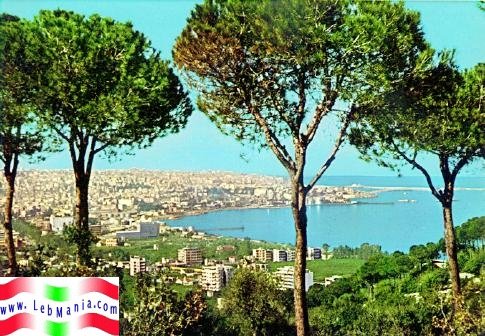
|
THE CITY THAT WOULD NOT DIE |
Beirut survived a decade and a half of conflict and so has earned the right to call itself “the city that would not die”. As if to demonstrate this resiliency, the Lebanese have launched a great rush of building activity, including the public service infrastructure. In the ruined City Center, a huge reconstruction project is underway to create a new commercial and residential district for the 21st century. |
| Commerce is second nature to Beirut, who long ago discovered that their port city on the East-West crossroads was ideally placed for trading and business of all kinds. A banking center with free currency exchange, the chief employment here is in trade, banking, construction, import-export and service industries. | 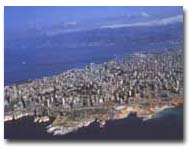 General view of Beirut |
| The Lebanese capital enjoys a vigorous press that publishes in Arabic, English, French and Armenian. Five Universities help keep ideas and innovations flowing. The flourishing art scene, including theater, filmmaking, music and plastic arts adds to the sense that is indeed a city on the move. |
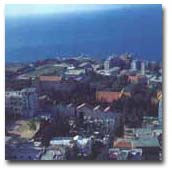
View of Bliss Street and AUB campus |
Its many
advantages also make Beirut a natural venue for international, regional or
local conferences and conventions. Beirut’s Port, the largest in the
eastern Mediterranean, is equipped to handle tens of freight a passenger
vessels. Further updating of its busy facilities will be made as part of
Lebanon’s general reconstruction plan.
Beirut International Airport, which serves the national carrier Middle East Airlines and numerous foreign airlines, will have an annual capacity of six million passengers by the star of the 21st century. |
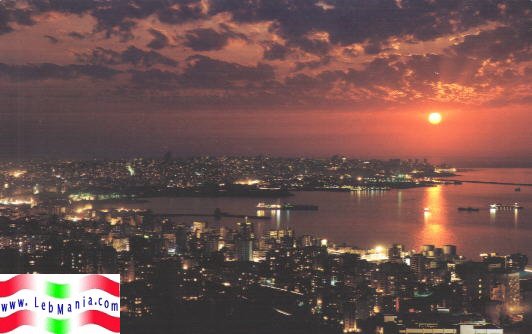
| But the power and the glory of Berytus were destroyed by a triple catastrophe of earthquake, tidal wave and fire in 551 A.D In the following century Arab Muslim forces took the city and in 1110 it fell to the Crusaders. Beirut remained in Crusader hands until 1291 when it was conquered by the Mamlukes. Ottoman rule began in 1516, continuing for 400 years until the defeat of the Trucks in World War I. The French Mandate period followed and in 1943 Lebanon gained its independence. | 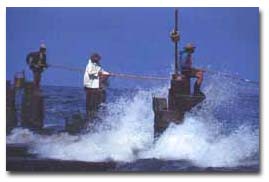
Fishermen off the the rocky shore of Beirut |
HISTORICAL HERITAGE |
| Beirut stands on the site of a very ancient settlement going back at least 5,000 years. Its name appeared in cuneiform inscriptions as early as the 14th century B.C. In the first century B.C. Berytus, as it was then called, became a Roman Colony and under Roman rule was the seat of a famous Law School which continued into the Byzantine era. |

UNCOVERING THE PAST |
| A city continuously inhabited for millennia, until recently most of the few archaeological discoveries in Beirut were accidental. However the war’s end in 1991 provided opportunity for more comprehensive and scientific investigation. |
| Beneath the ruined downtown area, which is under reconstruction, lie the remains of Ottoman, Mamulke, Crusader, Abbasid, Omayyad, Byzantine, Roman, Persian, Phoenician, and Canaanite Beirut. With luck, a good portion of Beirut’s history will be uncovered before reconstruction is complete. |
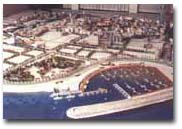
Model of the New Marina |
Beginning in 1993, archaeologists and builders began cooperating on just such a project. Teams from Lebanese and foreign institutions have found significant remains from each of Beirut’s historical periods. All discoveries are being carefully recorded and many will be preserved. |
RECONSTRUCTION
|
| The 1.8 million-square-meter reconstruction project for Beirut’s central District includes hotels, office space and residential areas. But not all the buildings will be new. Some 265 structures will be restored by 1998, plus historic mosques and churches. Beirut’s Souks or markets will be reconstructed in the traditional style by 1999. |
Solidere, the private company taking on the challenge of this 25-year project, plans a modern infrastructure of roads utilities, public areas and marine works. More than half a million square meters of landfill will provide land for two marinas, a seaside promenade and a green park. |
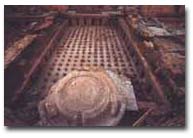
Roman Baths |
| SIGHTS AROUND BEIRUT |
ROMAN AND BYZANTINE STRUCTURES |
Group of five columns: These columns found o the left of the St.George Maronite Cathedral, were once part of a grand colonnade of Roman Breytus. They were found in 1963. |
Roman Exedra:Discovered west of the St. George Maronite Cathedral, this semi-circular building was moved in 1963 to Blvd. Charles Helou near the eastern entrance to the modern port. |
Roman baths:Behind Bank street are remains of the Roman bath which once served the city’s population. Originally discovered in 1968-69, it underwent a thorough cleaning and further excavation in 1995-1997. |
Four corniced columns:These columns in front of the parliament building in Nejmeh Square were discovered in 1968-69. |
Highly carved colonnade:Found in the 1940’s between Nejmeh Square and the Great Mosque, this five-column colonnade is part of the Roman basilica. The columns were later erected across from the National museum on Damascus Street. |
Floor mosaics: These mosaics came from a Byzantine church of the 5th century A.D. They were move from khalde south of Beirut to a site near the National Museum in the 1950’s. |
CRUSADER, MAMLUKE AND OTTOMAN STRUCTURES |
Medieval wall: An excavated wall dating from Crusader and Mamluke times can be seen north of Weygand Street along the old Patriarch Howayyek Street. |
Crusader castle:A large Crusader land castle once stood near the present port area. Excavations in 1995 revealed a large well-preserved section of the foundation wall complete with Roman column drums used as bond stones or reinforcements. |
The Grand Serial:Constructed in 1853 as an Ottoman military barracks, this building was the headquarters of the French governor during the French Mandate.After Lebanon’s Independence, it became the Governmental Palace. |
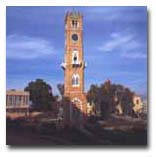
Ottoman Clock Tower |
Ottoman Military Hospital:Just in front of the grand Serial, this large building was constructed in 1860 as a military hospital. From the French Mandate Period until the 1960’s it served as Law Courts. Completely renovated, it now houses the Council for Development and Reconstruction. Ottoman Clock Tower:Located near the Grand Serial, this tower was built in 1897 and restored in 1994. |
MOSQUES |
Al-Omari Mosque: Originally the Crusader Cathedral of St. John (1113-1150 A.D.), the building was transformed into the city’s Grand Mosque by the Mamlukes in 1291. |
Zawiyat Ibn al’-Arraq:Built in 1517 by Mohammed Ibn al-‘Arraq ad-Dimashqi, this building was originally an Islamic sanctuary into late Ottoman times. It was rediscovered during the post-war clean-up process in 1991. |
Amir Assaf Mosque: Also called Bab es-Saray Mosque, this was built by Emir Mansour Assaf (1572-1580) on the site of the Byzantine Church of the Holy Savior. Located opposite the Municipal Building. |
Amir Munzer Mosque:The Amir Munzer Mosque was built in 1620 on an earlier structure. Also called Naoufara (Fountain) Mosque, there are eight Roman columns in its courtyard. |
Majidiyyeh Mosque: This mosque was constructed in the mid-19th century and named after the Ottoman Sultan Abdul Majid I (1839-1861). |
CHURCHES |
The Greek-Orthodox Cathedral of Saint George: Until the recent war in Lebanon this church, built in 1767, was the oldest functioning church in Beirut. The decorations on its walls were lost during the war. |
The Greek-Catholic Cathedral of Saint Elias: This mid-19th century church with it’s vaulted interior was once decorated with a marble iconostasis. |
The Saint Louis Church of the Capuchins: Inaugurated in 1863, this church served the foreign community of the Latin rite in Beirut. |
The Evangelical Church:This Church was built in 1867 by a group of Evangelical Anglo-American missionaries. |
The Maronite Cathedral of Saint George: Built in 1888, the style of this church is neo-classical. |
MUSEUMS |
National Museum: Opened in 1942 to house Lebanon’s archaeological treasures, the National Museum on Damascus Street is temporarily closed. Projects are underway to restore the building and gradually bring this national institution back to its former importance. |
Sursock Museum:A Museum of modern art located in the Sursock Quarter in Achrafieh. In addition to its permanent collection, it presents regular exhibitions of paintings, sculpture and other art forms. The Archaeological Museum of the American University of Beirut: Open weekdays 10 AM - 4 PM except on academic holidays. |
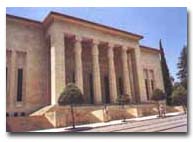
National Museum |
THINGS TO DO |
| University campuses are a
common venue for cultural events from abroad as well local productions. The
American University of Beirut and Lebanese American University, with their
lovely, park-like campuses are pleasant places to visit. |
TOURS |
| A number of tour companies
provide a wide selection of trips around Lebanon. |
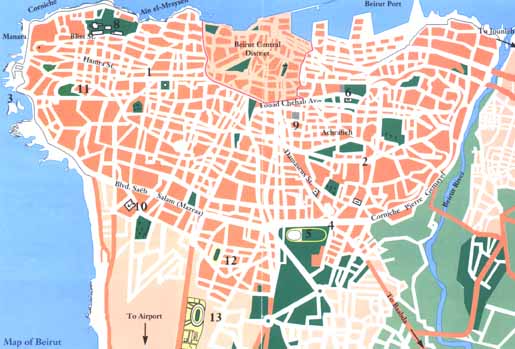 |
1. Tourism Information Office 2. Place Sassine 3. Pigeon Rocks and Raouche 4. National Museum 5. Horse Racing |
6. sock Museum 7. Archeological Excavations 8. AUB Campus nad Museum 9. St. Joseph University 10. Lebanese University |
11. LAU Campus 12. Arab University of Beirut 13. Sports City |
FOOD AND ENTERTAINMENT |
Restaurants specializing in Lebanese food offer a chance to sample this well Known Cuisine at its most authentic. A large selection of foreign restaurants serve cooking from around the world in surroundings as elegant or as cozy as you desire. |
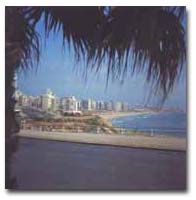
Ramlet el-Baida on the south coast of Beirut |
Nightlife in Beirut is non-stop. Discos, dinner dancing, bars and pubs of every variety invite visitors to join the fun. You can sample some of the trendiest places going or opt for super-sophisticated Nightclubs. The Casino du Liban, with its luxurious gaming rooms, is another favorite. |
TURKISH BATH |
The Al-Nouzha Bath, Beirut’s last operating public bath located in Basta Tahta, provides a real glimpse of old Beirut. Although not traditional in style, the scrub down You get is authentic. Sauna, steam room and massage facilities can be found as well. Women’s hours: Monday morning; men’s, all other times. |
SPORTS |
||
Those who appreciate the best in horse racing will enjoy Beirut’s racetrack, where every Sunday pure bred Arabians run. Beirut’s golf club is open to foreign visitors who can use the 9-hole course, swimming pool, a quash and tennis courts for a moderate fee. Along Beirut’s shores are many resort complexes, beaches and swimming clubs with aquatic amusements and sports on offer. More exercise is available at health clubs in the city. |
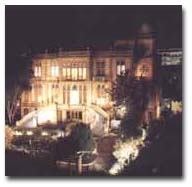
Sursock Museum |
|
RAOUCHE |
Raouche, on Beirut’s western-most tip, is a popular area with something for everyone. Its most famous landmark is Pigeon Rocks, huge formations which stand like sentinels off the coast. Numerous restaurants in Raouche serve local and foreign cuisine, while cliff-side cafes a good range of snacks. But walking and jogging are the favorite pastimes on this seaside promenade. The shores near Pigeon Rocks have yielded the oldest evidence we have of human existence on the site of Beirut. Flints and basic tools found here are displayed in the AUB Archaeological Museum. |
SHOPPING |
| Name what you want and it is almost sure to be available in the shops and street markets of Beirut. Traditional crafts, high fashion, jewelry or everyday needs, all are easy to find. Most standard shopping can be done in the Mar Elias area, Hamra Street, Rashied Karame street (ex: Verdun) Achrafieh and Furn El Shebback. Bargain hunters are urged to try Bourj Hammoud and Basta-Tahta. |
| Information Collected From The Ministry of Tourism |